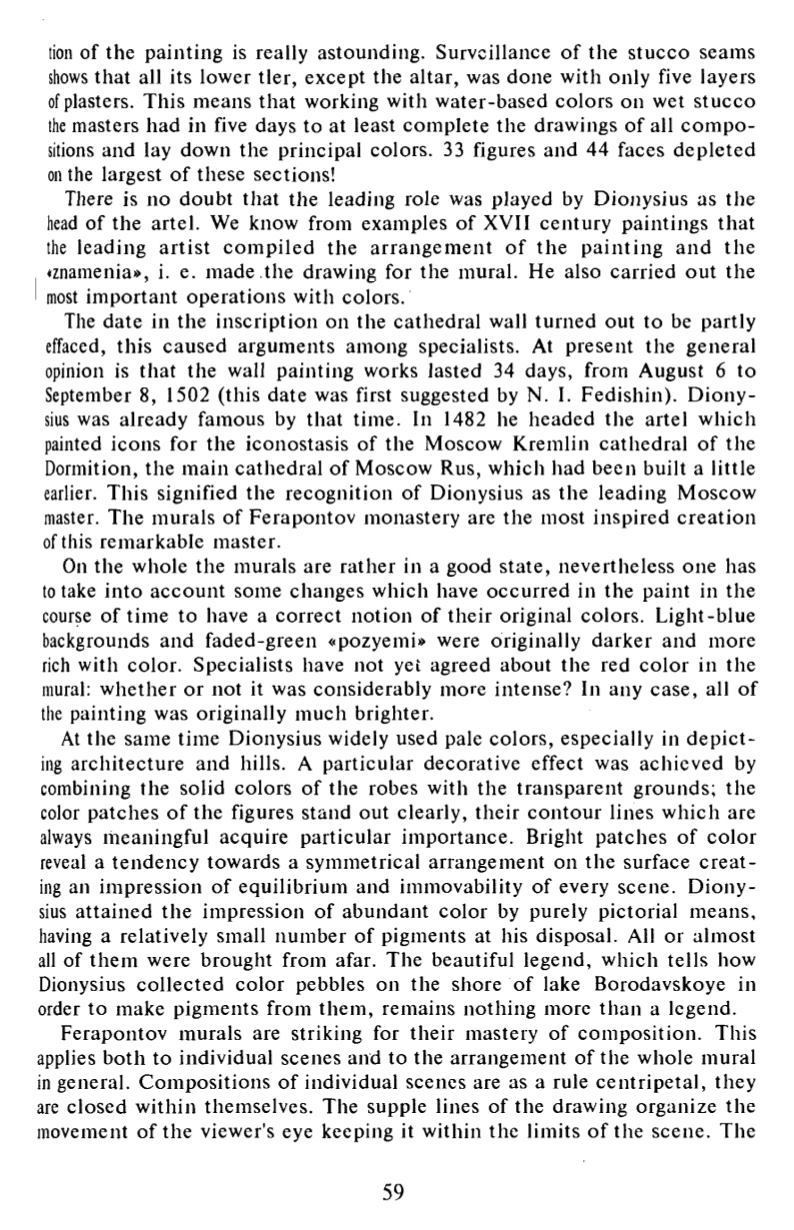

tion of the painting is really astounding. Surveillance o f the stucco seams
shows that all its lower tier, except the altar, was done with only five layers
of plasters. This means that working with water-based colors on wet stucco
the masters had in five days to at least complete the drawings of all c om po
sitions and lay down the principal colors. 33 figures and 44 faces dep le ted
on the largest o f these sections!
There is no doubt that the leading role was played by Dionysius as the
head of the artel. We know from examples of XVII century paintings that
the leading a rtist comp iled the a rrangemen t o f the p a in ting and the
♦znamenia», i. e. made the drawing for the mural. He also carried ou t the
most important operations with colors.
The date in the inscription on the cathedral wall turned out to be partly
effaced, this caused arguments among specialists. At present the general
opinion is that the wall painting works lasted 34 days, from August 6 to
September 8, 1502 (this date was first suggested by N. I. Fedishin). D iony
sius was already famous by that time. In 1482 he headed the artel which
painted icons for the iconostasis of the Moscow Kremlin cathedral o f the
Dormition, the main cathedral of Moscow Rus, which had been built a little
earlier. This signified the recognition of Dionysius as the leading Moscow
master. The murals of Ferapontov monastery are the most inspired c reation
of this remarkable master.
On the whole the murals are rather in a good state, nevertheless one has
to take into accoun t some changes which have occurred in the paint in the
course of time to have a correct notion of their original colors. Light-blue
backgrounds and faded-green «pozyemi» were originally darker and more
rich with color. Specialists have not yet agreed about the red color in the
mural: whether or not it was considerably more intense? In any case, all of
the painting was originally much brighter.
At the same time Dionysius widely used pale colors, especially in d e p ic t
ing architecture and hills. A particular decorative effect was achieved by
combining the solid colors of the robes with the transparent grounds; the
color patches o f the figures stand out clearly, their con tou r lines wh ich are
always meaningful acquire particular importance. Bright patches o f color
reveal a tendency towards a symmetrical arrangement on the surface c r e a t
ing an impression of equilibrium and immovability of every scene. D iony
sius attained the impression of abundant color by purely pictorial means,
having a relatively small number of pigments at his disposal. All or almost
all of them were brought from afar. The beautiful legend, which tells how
Dionysius collected color pebbles on the shore of lake Borodavskoye in
order to make pigments from them, remains nothing more than a legend.
Ferapontov murals are striking for their mastery of composition. This
applies bo th to individual scenes and to the arrangement of the whole mural
in general. Compositions o f individual scenes are as a rule cen tripetal, they
are closed within themselves. The supple lines of the drawing organize the
movement of the viewer's eye keeping it within the limits o f the scene. The
59















